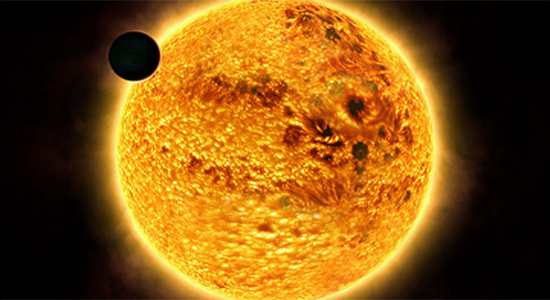
Artist’s impression of Jupiter-sized planet HD 189733b. Credit: ESA, NASA,
Frédéric Pont (Geneva University Observatory)
Jan 10, 2014
Could there be Earth-like planets circling other stars in our galaxy?
HD 189733b is not an Earth-like planet. It is larger than Jupiter and circles so close to its parent star that the atmosphere reaches more than 800 Celsius. HD 189733b represents the majority of worlds that have been discovered revolving around other stars. Most of them are located in close orbits, and most of them are gas giants.
The primary reason for the large number of planets in this group is the detection methods used to find them. Astronomers started out looking for planets around other stars by analyzing how the stars were moving. It was thought that a star with a planet swinging around it would show minute changes in its spectrum as it was pulled side-to-side by gravitational inertia. As the planet’s mass pulled on the star, it would create a “wobble” in the spectrum. Based on the size of that wobble, a determination of the planet’s mass could be made.
Since the initial instrumentation was not as sensitive as later versions, it was the larger more gravitationally influential planets that were located first. Now, there have been hundreds of planets discovered, some with an Earth-like mass.
The Kepler mission, a one-meter-diameter NASA space telescope launched March 7, 2009, uses a new technique to count Earth-sized planets in the habitable zones around other stars. When a planet passes in front of a star, the starlight is expected to dim slightly. Kepler will search for that subtle flicker, with complete data analysis available as of late 2013, it is expected that Kepler will more than double the catalog of extra-solar planets.
According to the Electric Universe theory, planets ought to be found around other stars. There is a mechanism that causes planetary birth and subsequent electrical interactions during close encounters with other bodies. Stars “give birth” electrically in a discharge from their charged interiors. Since stars are not powered by hydrogen fusion but by incoming electric currents, whatever fusion does take place is most likely taking place close to or on the surface. There is no super-compressed, intensely hot core, radiating energy from thousands of kilometers deep inside. Instead, heavy elements are synthesized in the exterior plasma discharges and then “precipitate” into the star’s interior like a rain of metal atoms.
According to EU physicist Wal Thornhill:
“External electrical or gravitational stresses on a star may cause some of its internal positive charge to be offset from the center of the star. And since like charges repel, the offset charge will tend to accelerate toward the surface. It is a form of internal lightning. This process may lead to the expulsion of a substantial portion of the positively charged interior of the star. The visible result is a nova, or star-wide lightning flash, as electrons in the stellar atmosphere rush toward the emerging positively charged matter. The ejected material constitutes a powerful electric current, which generates its own magnetic field. That magnetic field constricts the charged matter to form a jet. The leading matter is neutralized and stops accelerating, causing the following charged matter to pile into it. So is born a companion star or gas giant planet. This explains why so many stars have been found to have extremely close-orbiting gas giant planets.”
As orbits adapt to a new stable configuration, dust, stones and boulders arriving from space or blasted from distant parts of the same body are deposited. Plasma etching, combined with ionic discharges, are responsible for rounding the rocks, scattering them uniformly across the landscape, and leaving “flow streaks” from electrical “winds.” Blowing gases and flowing liquids require action over long spans of time. Electrical erosion, caused by forces billions of times stronger than mechanical forces, can achieve observed effects in short times.
Electric Universe advocates predict that when it becomes possible to send probes to other star systems like our own, we will most likely find similar planetary systems in orbit around them. The electric forces that formed and energize this planet most likely formed the exoplanets, so it is expected that we will find Earth-like planets sooner or later.
Stephen Smith
Click here for a Spanish translation












